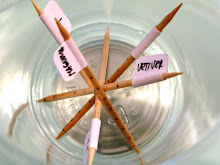Most often than not mixing different aroma ingredients produce best results when mixed oils have the same odor intensity and no particular element stands out. Otherwise the whole accord appears to be unbalanced and unsophisticated.
Odor intensity of essential oils and aromatic compounds vary greatly. For example, it will take over 100 drops of Sandalwood Oil to balance just 1 drop of Cistus (and this is even without taking into account effect of
Odor Slope which will be discussed later).
In order to create even simple mixtures knowledge of Odor Strength of all the ingredients in the formula is of the utmost importance. That means that you should study you own aroma library well before attempting complicated combinations. This will save you a lot of time, material and you will avoid a whole bunch of frustrations that a weekend perfumer is predestined to face anyways ;-)
Most of the time information about Odor Strength of oils is limited to “strong/medium/weak” ratings. Obviously, this is not enough. My search for authoritative sources of such information didn’t produce much except repetitive statements that it is very subjective and that even the same oil from multiple suppliers might have drastically different Odor Intensity. Even knowledge of Vapor Pressure and Molecule Weight are not very helpful, because human nose processes smells in rather unpredictable ways.
First we should choose particular oil that will be used to compare with all the other oils in the library. I would recommend
VETIVER.
There are several reasons for choosing Vetiver as a benchmark for normalizing Odor Strength of essential and fragrance oils:
- Its own Odor Strength is in the middle of the spectrum;
- This is a distinct BASE note and it will last on a blotter for a long time without much change to perceived Odor Intensity;
- It has a very distinct Odor, which can be described as deep smoky-dry, earthy-woody and slightly sweet. It is easier to recognize Vetiver in simple combinations.
- And finally, this is a rather common and affordable ingredient. Most supplies will have Vetiver in their stock.
The process of comparing Odor Strength for oils is based on
Weekend Perfumer’s Sniffing Technique using ordinary toothpicks instead of blotters as it allows a lot better precision and easier handling.
10% Vetiver Etalon
Please mark the first toothpick in a special way and dip it 5mm (1/4 inch) into undiluted Vetiver oil – this will represent Odor Intensity of a single drop of a 10% Vetiver dilution (5 cm / 2 inches of a toothpick absorbs 1 drop of an oil).
Note: majority of oils should not be smelled directly from bottles as it may temporarily reduce your ability to perceive odors.
Studying Your Aroma Library - Testing Oils
- Dip new toothpick 5mm deep into the oil and compare it to 10% Vetiver Etalon. If oils appear to be of similar intensity, it would mean that 10% Vetiver = 10% Tested Oil
- If Tested Oil appeared to be weaker, then try to dip it 10mm and compare results again. Repeat the process until similar intensity has been achieved. Every 5mm represent 10%. So, if Tested Oil produced similar intensity at 30mm dip, that means that: 10% Vetiver = 30% Tested Oil
- If Tested Oil is weaker, you may try to dip new toothpick less than 5mm, but that process becomes a little tricky. I would recommend making a 10% dilution of the Tested Oil using Perfume Alcohol. Then each 5mm will correspond to 1% of the Tested Oil. For example, if 10mm dip of a 10% dilution of the oil produced a similar Odor Strength to the Etalon that means that: 10% Vetiver = 2% Tested Oil.
- And if 10% dilution is still too strong to provide precise results, continue with further diluting the oil down to 1% and do the testing. Some oils such as Oakmoss (EOS), Leather (TGSC), Rose De Mai (EOS), Violet Leaf (E7) and others require 0.1% dilutions not to overpower 10% Vetiver Etalon!
I have summarized results of my tests of my own library of essential oils and aromatic compounds in
AromaLibrary.com Clearly, this is an ongoing process as rather often I would review my own findings at a later date and I would suggest to consider data regarding Odor Strength only as a guideline for your own discoveries.
Ok, and here is the main treasure:
continuously updated table of Essential Oils and Aromatic Compounds in Google Spreadsheet format.
Good luck with your weekend creations!





































